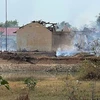Vientiane (VNA) – According to the Lao Statistics Bureau, the country's inflation rate in the first quarter of 2023 was 40.85%, one of the highest in the region.
Although the country's inflation rate fell slightly from 41.3% in February to 41% in March, the overall inflation rate in Laos remains very high.
The high cost of goods and services in Laos is due to both internal and external factors. The conflict in Ukraine disrupted supply chains while the US Federal Reserve raised interest rates, making the USD stronger against Asian currencies, including the Lao kip.
The depreciation of the kip against the USD and Thai baht is one of the main factors driving inflation in Laos. The weak kip makes it difficult for the Lao government to contain the escalation of goods and service prices, especially as one-third of the goods used to calculate the price increase in Laos are imported.
In the Southeast Asian country, most of the machinery, animal feed, fertiliser, fish fingerlings, and many agricultural inputs are imported.
To deal with inflation, Director of the Monetary Policy Department, State Bank of Laos, Soulisack Thammavong said that the bank will continue to tighten monetary policy and manage the exchange rate which is considered a measure to curb inflation.
To tighten monetary policy, the central bank in February 2023 also raised the reserve requirement to 5.5% for kip and 8% for foreign currency. The Lao Government also committed to managing commodity prices in local markets to minimise the rising prices’ impacts on the poor./.























